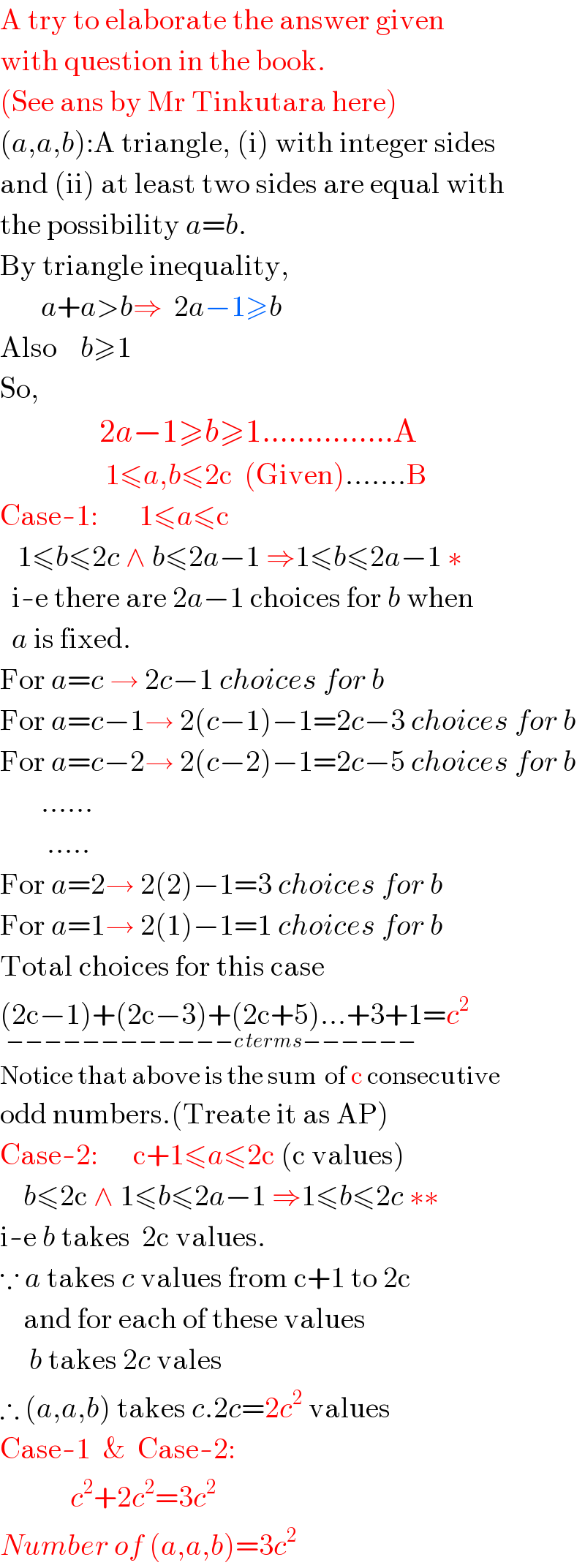
Question and Answers Forum
Question Number 34870 by Tinkutara last updated on 12/May/18

Commented by Tinkutara last updated on 15/May/18
please help
Commented by Tinkutara last updated on 16/May/18
Anyone please see it.
Commented by Tinkutara last updated on 16/May/18

Commented by Tinkutara last updated on 16/May/18
Actually this was the whole comprehension.
Answered by Rasheed.Sindhi last updated on 20/May/18
![Pattern approach Using strategy of Q#34760,we can determine ′number of triangles′ for various values of c:(In the following N denotes number of triangle.) ((c,N),(1,3),(2,(12)),(3,(27)),(4,(48)),(5,(75)),(⋮,⋮) ) Number of triangles(N) make following sequence : 3,12,27,48,75,108,.... We can easily determine general term: [(c,1,2,3,4,5,6,(..)),(N,3,(12),(27),(48),(75),(108),(..)),(,(3.1),(3.4),(3.9),(3.16),(3.25),(3.36),(..)),(,(3.1^2 ),(3.2^2 ),(3.3^2 ),(3.4^2 ),(3.5^2 ),(3.6^2 ),(..)) ] Hence general term is 3c^2 Number of triangles : 3c^2](Q35538.png)
Answered by Tinkutara last updated on 22/May/18

Commented by Tinkutara last updated on 22/May/18
This was the solution. Can you please elaborate it? I can't understand it.
Answered by Rasheed.Sindhi last updated on 24/May/18

Commented by Rasheed.Sindhi last updated on 24/May/18
![∗ For 1≤a≤c b≤2c ∧ b≤2a−1 ⇒b≤2a−1 [ b≤2c ∧ b≤2a−1⇒b≤min(2c,2a−1) 1≤a≤c⇒2≤2a−1≤2c−1 ⇒2a−1≤2c So 2a−1 is always less than 2c ] ∗∗ For c+1≤a≤2c b≤2c ∧ b≤2a−1 ⇒b≤2c [ b≤2c ∧ b≤2a−1⇒b≤min(2c,2a−1) c+1≤a≤2c⇒2c≤2a−1≤4c−1 So 2c always less than 2a−1](Q35827.png)
Commented by Tinkutara last updated on 24/May/18
Thank you very much Sir! I got the answer. ��������
